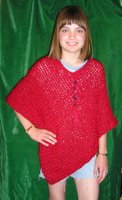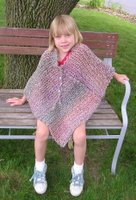
What happened to summer? There we were, working in the garden, picking tomatoes for gazpacho, hot peppers to can for salsa, and pickles for, well, pickling. It was 80° and sunny. Two weeks later, and we've got cold rainy days where the highs never get out of the 50's, and we have already had our first frost advisory. Wow, you'd think we lived in Wisconsin, or some place like that!
So what to throw on for warmth in this brisk fall weather? How about a poncho! Ponchos are a fun, fast, and very easy project for the loom knitter. Your basic poncho can be made quite simply by knitting two rectangles that are joined short side to long side. In fact, it took less than a weekend each to make the two ponchos shown here. Both ponchos use the same basic pattern.

For Eldest Daughter's poncho (she's my tall ten-year-old), I loom knit two flat panels using 35 pegs (all but one) on the Knifty Knitter round green loom. The only reason I made these panels 35-pegs wide was because this gave me a 17" to 18" wide rectangle.
For the red poncho, I started both rectangles by wrapping the pegs, then purling one row, knitting the next back, purling the third row, knitting the fourth, then purling the fifth (5 rows total).
This is not required, it just makes the short ends lay flatter and makes them a little easier to join. Then I e-wrapped and knit 70 more rows, then ended with five final rows of purl, knit, purl, knit, purl, for 80 total rows. My rectangle was approximately 27" to 28" long — 10" longer than it was wide. For my slightly smaller Youngest Daughter's poncho (she's my six-year-old), I loom knit the same number of pegs in width, but knit it to only 26" to 27" long — 9" longer than it was wide.
Okay, the magic number here is the difference between the short and long measurements. For a small child, I make the difference about 9". For an older child or small adult, I make the difference about 10". For a large adult, I knit a panel that is closer to 20" wide and make the difference about 11". When it comes time to join your rectangles, make sure that when you lay the pieces together, there is the correct 9", 10" or 11" left between the piece you joined and the edge of the long side. What this means is that your 17"-wide edge takes up 17" of the long side (either 26" or 27" for these two ponchos).

For the cream, blue and pink poncho, I used the mock crochet stitch for all rows. Because the mock crochet stitch lies flat, I did not need to create a flat edge by alternating rows of knits and purls.
Once you have two rectangles of approximately 17" by 27", it is time to join them. The best way to visualize what you are about to do is to cut yourself two 2" by 4" rectangles out of paper. Tape one short end of
rectangle one down to the bottom edge of the long side of
rectangle two — you'll have an "L" shape when the two pieces are attached together. Now take the short side of
rectangle two, and curl it around until you can tape it to the long side of
rectangle one. It's really not as complicated as it sounds once you work it out with your two pieces of paper. To make the joining easier, mark that 9" or 10" point on the long side of
both rectangles (the amount that will be left over and form the neck opening in the poncho) with a piece of contrasting yarn. It will be much easier to stitch the second edge together if you already know where the ends should fall.
Stitch together one edge (whipstitch, mattress stitch, whatever works for you), then stitch the other edge, and you're done. I wove in all the tails except for two long ones at the front neckline, where I added some blue beads for accent on the red poncho. For the detail on the cream, blue and pink poncho, I used pretty veined marble beads from an old necklace to trim and finish it.
[Loom: Knifty Knitter round green loom, 5/8" gauge. Yarn: Lion Brand Homespun, Candy Apple and Quartz.]

















